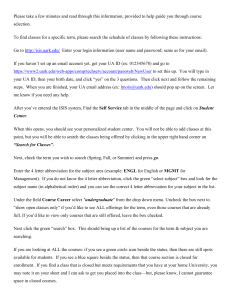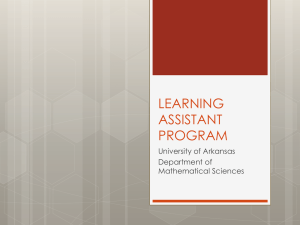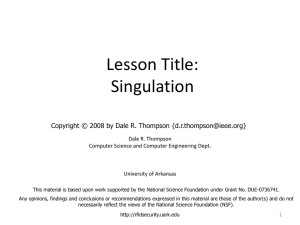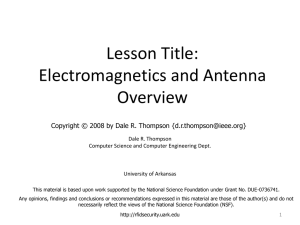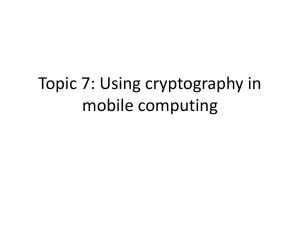PPT - University of Arkansas
advertisement
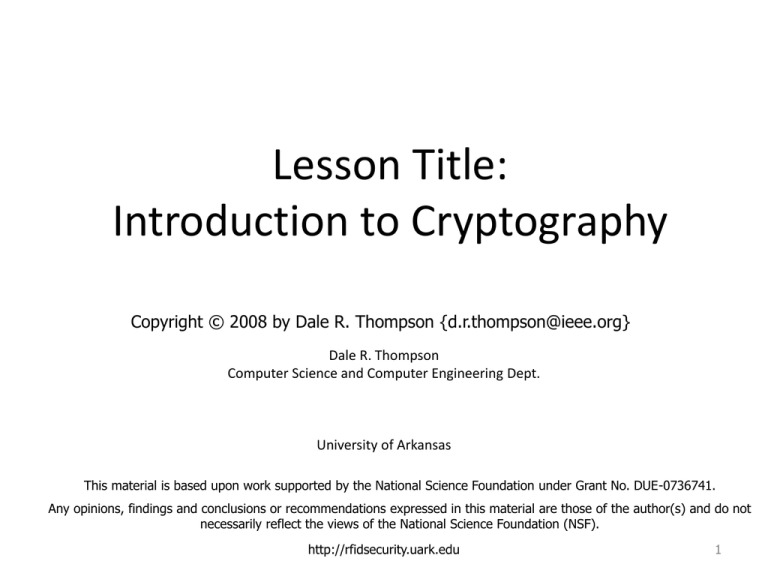
Lesson Title:
Introduction to Cryptography
Copyright © 2008 by Dale R. Thompson {d.r.thompson@ieee.org}
Dale R. Thompson
Computer Science and Computer Engineering Dept.
University of Arkansas
This material is based upon work supported by the National Science Foundation under Grant No. DUE-0736741.
Any opinions, findings and conclusions or recommendations expressed in this material are those of the author(s) and do not
necessarily reflect the views of the National Science Foundation (NSF).
http://rfidsecurity.uark.edu
1
Cryptography
• Cryptography is the study of encryption and
decryption schemes.
– Used to uphold the security principles of
confidentiality and integrity
http://rfidsecurity.uark.edu
2
Symmetric-key cryptography terms
•
•
•
•
•
•
Also know as secret-key or single-key cryptography
Plaintext – It is the original message or data
Encryption algorithm – It scrambles the message by performing substitutions and
transformations on the plaintext based upon a key. The output of the encryption
algorithm is called ciphertext.
Ciphertext – It is the scrambled version of the plaintext that the encryption
algorithm produces.
Key – It determines the particular type of transformations and substitutions
performed by the encryption algorithm. A different key produces a different
ciphertext. The key must be kept secret. The key is usually a bit string
representing a number. If the algorithm is secure/good, the bigger the length of
the key the more secure the data is.
Decryption algorithm – It is the algorithm that unscrambles the ciphertext to the
original plaintext given the correct key.
http://rfidsecurity.uark.edu
3
Symmetric-key Cryptography
http://rfidsecurity.uark.edu
4
Exclusive-OR (XOR) Cryptography
http://rfidsecurity.uark.edu
5
Block vs. Stream Ciphers
• Block cipher – It is an encryption/decryption
algorithm in which data is processed in blocks.
A block of plaintext produces an equal-length
block of ciphertext.
• Stream cipher – It is an encryption/decryption
algorithm in which the data is processed one
bit or byte at a time.
http://rfidsecurity.uark.edu
6
Examples of block ciphers
• Data encryption standard (DES)
–
–
–
–
–
1977
NIST
64-bit blocks
56-bit key
Too small for many applications today
• Triple DES (3DES)
–
–
–
Apply DES three times
Two-key version (2x56 = 112-bit key)
Three-key version (3x56 = 168-bit key)
• Advanced encryption standard (AES)
–
–
–
–
–
–
NIST Standard in 2001 after contest
128-bit block size
Key sizes: 128-, 192-, or 256-bit key
Larger block size more efficient and secure
High throughput (fast)
Efficient
http://rfidsecurity.uark.edu
7
Stream cipher
http://rfidsecurity.uark.edu
8
RC4 stream cipher
• Variable key: 1-256 bytes
• Uses
– Secure sockets layer (SSL)
– Transport layer security (TLS)
– Wired equivalent privacy (WEP)
– WiFi protected access (WPA)
http://rfidsecurity.uark.edu
9
Asymmetric-key cryptography
• Two different related keys
– Public key for encryption
– Private key for decryption
• Based on functions that are easy to calculate
one way but computationally difficult to
calculate the other way.
• Two problems are solved
– Key distribution
– Digital signatures
http://rfidsecurity.uark.edu
10
Asymmetric key generation
http://rfidsecurity.uark.edu
11
Asymmetric-key Cryptography
Alice encrypts message for Bob
http://rfidsecurity.uark.edu
12
Asymmetric-key cryptography
examples
• RSA
– 1024-, and 2048-bit keys are common
– Cannot compare length of keys directly to
symmetric cryptography key lengths
• Elliptic curve cryptography (ECC)
– For the same key length, ECC is more secure than
RSA
http://rfidsecurity.uark.edu
13
Hash function
• Hash function – It accepts a variable-length
message and outputs a hash value (hash code,
message digest)
http://rfidsecurity.uark.edu
14
Hash function examples
• MD5
– Produces 128-bit hash value
• Secure hash algorithm (SHA-1)
– 160-bit hash value
• SHA-256, SHA-384, SHA-512
– Created after AES
http://rfidsecurity.uark.edu
15
Hash function threat
• An attacker can substitute file and recalculate
the hash value of the new file.
http://rfidsecurity.uark.edu
16
Message authentication code (MAC)
• Also called a cryptographic checksum
• The MAC is a function of the message and a
secret key shared between the sender and
receiver to authenticate the sender to the
receiver
• An attacker cannot create the correct MAC
because he does not know the secret key.
http://rfidsecurity.uark.edu
17
MAC calculation by sender
http://rfidsecurity.uark.edu
18
MAC verification by receiver
http://rfidsecurity.uark.edu
19
MAC examples
• Use a block cipher
• HMAC
– Use standard hash function
– key
http://rfidsecurity.uark.edu
20
Digital signature
• Requirements
– Verify author, date, time of signature
– Authenticate the message
– Verifiable by a third party to resolve disputes
• Examples
– Any asymmetric-key cryptography like RSA or ECC
– Digital signature algorithm (DSA)
http://rfidsecurity.uark.edu
21
Asymmetric-key Cryptography for Digital Signature
Alice signs message and Bob verifies it
http://rfidsecurity.uark.edu
22
Authentication protocol terms
• Authentication – It is the process of determining if an entity, whether an
individual or an object, is who/what they claim to be. Some evidence has
to be provided to prove the claim such as what they know, what they
have, or what they are. Passwords are the most common form of
authentication and are an example of what a user knows.
• Protocols – Protocols define the series of messages exchanged between
two or more entities and their meaning.
• Mutual authentication protocol – It permits parties to verify each other’s
identity. This is important before exchanging keys or data.
http://rfidsecurity.uark.edu
23
Authentication protocol threat
• Replay attack
http://rfidsecurity.uark.edu
24
Asymmetric-key cryptography to establish a session key
(simple authentication protocol)
http://rfidsecurity.uark.edu
25
Contact Information
Dale R. Thompson, Ph.D., P.E.
Associate Professor
Computer Science and Computer Engineering Dept.
JBHT – CSCE 504
1 University of Arkansas
Fayetteville, Arkansas 72701-1201
Phone: +1 (479) 575-5090
FAX: +1 (479) 575-5339
E-mail: d.r.thompson@ieee.org
WWW: http://comp.uark.edu/~drt/
http://rfidsecurity.uark.edu
26
Copyright Notice, Acknowledgment, and Liability
Release
•
•
•
Copyright Notice
– This material is Copyright © 2008 by Dale R. Thompson. It may be freely redistributed in its entirety
provided that this copyright notice is not removed. It may not be sold for profit or incorporated in
commercial documents without the written permission of the copyright holder.
Acknowledgment
– These materials were developed through a grant from the National Science Foundation at the
University of Arkansas. Any opinions, findings, and recommendations or conclusions expressed in
these materials are those of the author(s) and do not necessarily reflect those of the National
Science Foundation or the University of Arkansas.
Liability Release
– The curriculum activities and lessons have been designed to be safe and engaging learning
experiences and have been field-tested with university students. However, due to the numerous
variables that exist, the author(s) does not assume any liability for the use of this product. These
curriculum activities and lessons are provided as is without any express or implied warranty. The
user is responsible and liable for following all stated and generally accepted safety guidelines and
practices.
http://rfidsecurity.uark.edu
27

